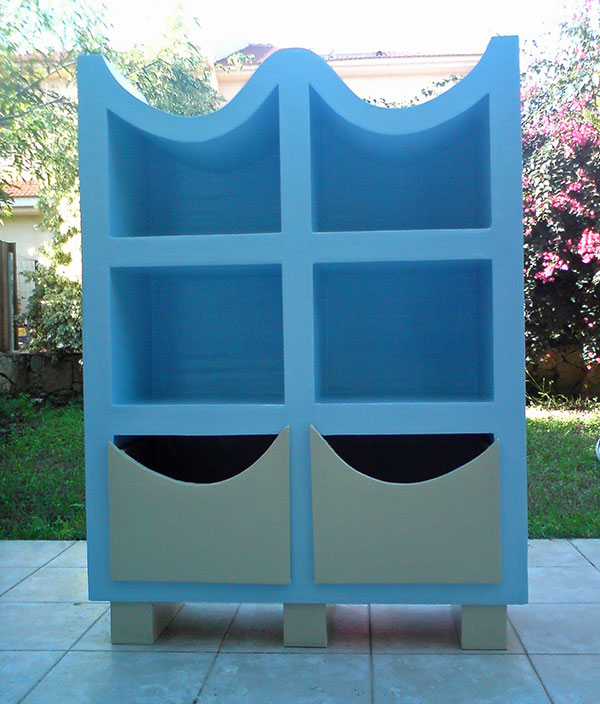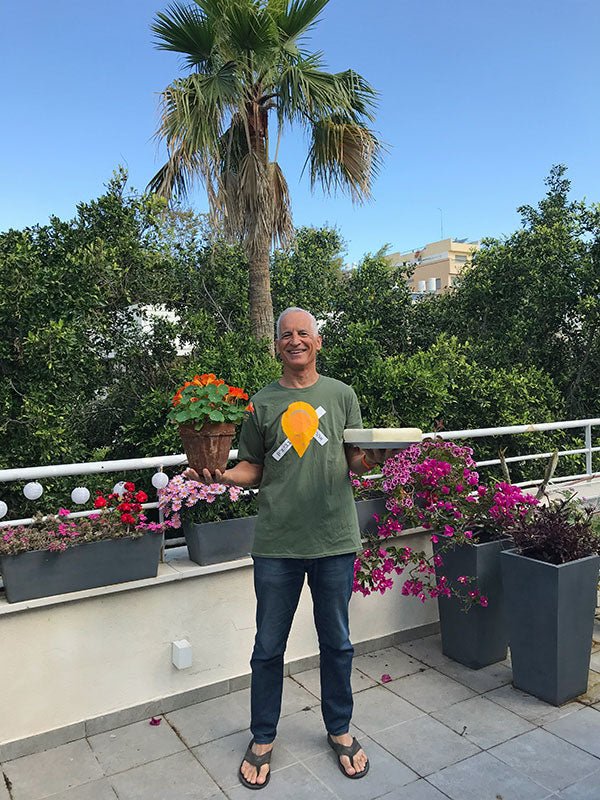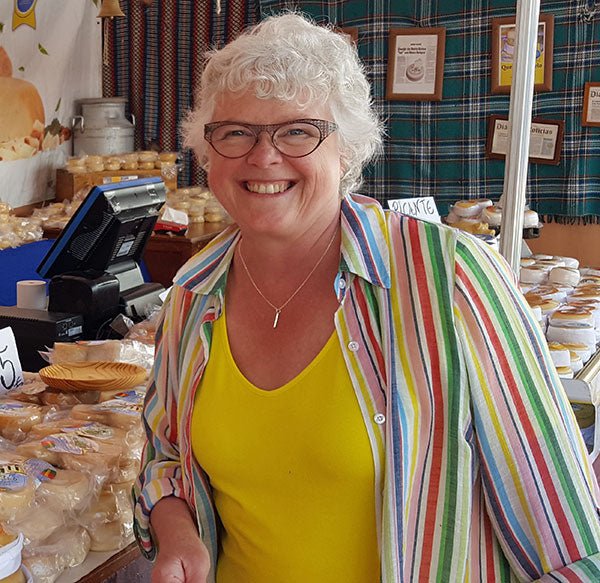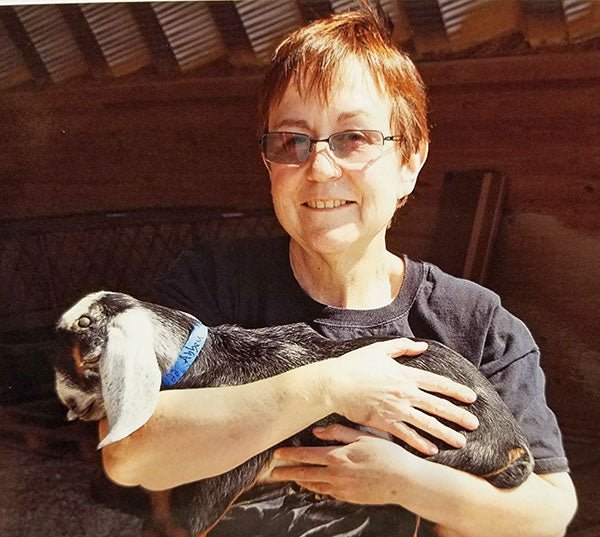
I am 66 years old, married, have three children and five granddaughters, all of them heavy and knowledgeable cheese consumers. I am a computer specialist by profession, worked 11 years for IBM as a Systems engineer and left to start my own business. I retired 6 years ago, so I have plenty of time to maintain some hobbies besides the cheese – surfing and paddling in the sea, swimming (I am a former national water polo player) and skiing. So, mainly in or on water…


Combining paddling technique with dairy work in France.

On the slope with my wife, Yael, (sportive woman and also a keen customer of my dairy).
Fifteen years ago, while I was living in the Galilee (northern Israel), I learned two interesting things:
First is the construction of furniture from cardboard. You can get an idea of it at my website, mostly in Hebrew (not shipping to the US), but try to use the built in google translation or just enjoy the pictures – https://yoelgreenbrown.wixsite.com/yoelcell

A small cupboard in a whale shape in production, for children’s room.

Small cupboard with Japanese look.


Second is the producing of cheese. I started studying cheese making in regular courses given by the Ministry of Agriculture. Since then, I have been traveling abroad at least once a year (France, Italy, Spain, Portugal, and Switzerland etc.) to study in schools, conferences and with local cheese makers in artisan dairies. This helped me to improve my skills and broaden the variety of cheeses I make. I produce the cheese in my home micro dairy (kitchen) in the heart of Tel Aviv.

Primary and secondary ‘Cave.’ Temp controlled by thermostat.

Cave’s content, low stock. Water bowl for humidity, temp and humidity display, baby Gouda, Tallegio and pecorino semistagionato.
I produce the cheeses mainly from sheep’s and goat’s milk which I buy in a farm located 20 minutes drive from Tel Aviv. I usually make cheese in batches from 5-7 gallons (20-25 liters) of milk, four types of cheese each time. I use a fridge converted to a “maturation cave.” Some of my recipes are, of course, from cheesemaking.com. An example of one long day’s crop, still in molds, can be seen in the picture below:

From right to left: Valencay, Sainte Maoure, Camembert (two of them with garden nasturtium flowers, which I grow on my roof terrace), Taleggio and Pecorino Semi Stagionato)
Sometimes I use supplements like truffles and saffron, as well as flowers, which I grow or pick in the backyards of the city(!). For example, nettles, with which I make a local Israeli version of Yarg cheese.

Cheeses wrapped with nettles and nasturtium leaves (middle).
All the cheeses I prepare are for the private consumption of family members and friends.
The world of cheese is very wide and fascinating and being involved in it, not only produces tasty and interesting products, it also serves me as a platform to travel in the world and to get to know interesting people from the community of cheese makers.

Cheese assortment (top down left to right): Local plain Tsfatit, Sainte Maure, Cabra Al Vino, Self-invented semi hard with black pepper, Morbier with ash, Tsfatit with Nigella seeds
How did you get started making cheese?
Fifteen years ago, my family fulfilled an old dream and moved from the big city of Tel Aviv to a small settlement called Kamon on a mountain in the Galilee (northern Israel), which is a rural area. There I studied cheese making, which I learned in several courses by the Ministry of Agriculture. I knew the world of cheeses but as a cheese consumer, not as a maker.
At first, I used basic equipment and made basic cheeses (Tzfatit and Cherkassit (both of them local soft cheeses), Camembert, Haloumi, Gouda and more). Some of them I sold in the community (140 families). I came to be in a situation where children ran after me and asked when there would be cheese. Working with cheese was a hobby, alongside my work.
At that time, I made my cheese mainly from the milk of goats and also from a single cow that belonged to an old neighbor Bedouin woman. At one point, I was invited to a wedding of her grandson and there I ate a tasty meat dish. Only the day after I was told that we ate that cow!
What are you making now?
I make a large number of cheeses, many of which I have learned to make in the original area where they are made in Europe. The list is long, so I will only mention some of them:
Italian: Bra, Crampiolo, Taleggio, Pecorino, Castelmagno, Caciotta.

Lingotto d’Oro (Italian). If you are close, a visit or even a
sleep over in this place is a must!

Pecorino with chestnut leaves (Italian)
Spanish: Cabra al Romero, Castello, Tetilla, Ibores, Manchego.
French: Tomme, Tomme au Marc, Morbier with Truffles, Saint Maure, Pont l’Eveque, Saint Paulin.

Tomme au Marc (French)

Morbier (French)
English: Derby with Sage.

Derby with Sage

Monkland (English). A modern invented cheese – for details click here.
Swiss: Alpine, Gruyere.
I try to make them tasty but also to resemble the original taste. In addition, I sometimes like to add my own twist, such as adding flowers that I grow, nettles that I pick in Tel Aviv, Gouda with grounded coffee that is the strangest but quite good, and more.

Camembert cheese with nasturtiums inside.
What effect do the nettles and the nasturtiums have on the taste of the cheese?
The nasturtiums, flowers and leaves for example, have a fantastic, delicate, bitey, mustard taste. The wild pansies are more towards sweetness. The nettles give a very definite taste but I cannot describe it.
Anyway, when I enter the kitchen that I have turned into a dairy, I am in one of two moods:
1. The serious one, where I make the cheeses exactly as they are originally – for example, Tomme – as in Haute Savoie and Castelmagno – as in Piedmont. It is like entering a classical music concert. Try even not to cough!

2. The other one is the mood of adventure. It is like entering a jazz club for a jam session – besides the music, you hear the waiters, the sound of wine glasses and you do not take yourself seriously. Being in this mood, I use the flowers and all the other ingredients. Most of the time I cannot repeat and do the same cheese again.
Have you had any problems along the whey?
The only obstacle I face is pasteurization (147F (64C) for 30 minutes) but I try to overcome …
In Israel, dairies must, by law, pasteurize, period. We have local issues like hot climate and some communities own illegal sheep and goat pens which prevent eliminating completely the Brucella’s threat. On top of it, there is a common global problem, which is the laziness of the authorities, not just in the field of milk. For them, it is easier to have clear cuts.
As a home cheese maker, I am not bound by this regulation, as I am not selling my cheese. I buy milk from a very secure and controlled farm but I pasteurize anyway, to be on the safe side, especially since most of my “customers” are my relatives so I have a big interest in their health. I heat only to 147F (64C) for 30 minutes to limit the damage.
Would you say that cheese is a big part of Israeli culture?
The Land of Israel was described (and called) in the Torah the “land flowing with milk and honey.” Israel celebrates Shavuot (June), a biblical holiday, which was the day the Torah was given to the Israelites in the Sinai desert. There are also agricultural, agrarian roots and meaning of the holiday, as it is also the celebration of the wheat harvest and the ceremony in which the first fruits (Bikkurim) are being presented.
One of the customs of this holiday is to eat dairy products, especially cheeses, and this is the “hot” season for the cheese makers. Cheesecakes are also the stars of these 3 days. The milk industry is very advanced in Israel, and there are several high tech companies dealing with robotic cowsheds, milking equipment and controlling the cows using high tech technologies, which are being exported to all over the world. The consumption of soft cheeses and dairy delicacies is high and there is a big variety of imported cheeses from Europe.
Regulations and supervision in the field of milk are very high and strict, so, opening a dairy is complicated and difficult to perform. Despite that, there are quite a large number of small and medium-sized dairies which produce very high quality cheese, being run by passionate and knowledgeable cheese makers. They mainly produce versions of European cheeses but there are also more and more original cheeses being made, which represent our terroir and character in a better way.

Yoel with his daughter, and a few of his granddaughters, celebrating Shavuot with two symbols of the holiday: wheat and milk.
You have traveled to many countries to learn to make their fabulous cheeses- you’ve really taken home cheese making to the highest level!
Regarding traveling for cheese: I belong to a group of around 40 cheese makers, some of whom are professionals running artisan dairies and some of whom are, like me, making cheese as a hobby. We travel in groups of 20 and also meet in Israel to make cheese together and to exchange information and knowledge. So, it has also a social aspect, not just cheesy.
Seeing and being in lot of places, I can tip you. If you are limited in time or budget or will and want to choose one place/event to attend, go to the cheese biennial in Bra in Piedmont Italy. It takes place in September of each uneven year, so you can catch it this year – 3 days of lectures, seminars and street food with cheese booths from all over the world.
Bra is the cradle and capital of the Slow Food organization and it is a real Italian pearl. It is a huge event and quite packed but definitely worthwhile. In 2017, there were 300 exhibitors/participants and something like 400,000 visitors. Being close to the villages of Barolo and Barbaresco where the best Italian wine is produced, and adding the fantastic Italian cheeses – you are in heaven.
Bra in 2017:

One of the venues.

Studying how to match wine to cheese. Final conclusion: “Choose a good cheese you like, with a good wine you like, and have them with a good friend!”

Comparing 8 different kinds of Camembert and studying how to taste them. Don’t forget the wine….
And if, by chance, you find yourself in Tel Aviv, you are invited for a visit and tasting in the dairy. (labda7@gmail.com)














































































































































